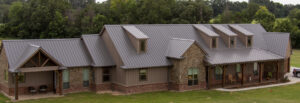When it comes to roofing, homeowners need to consider both style and material. They must choose a material that will not only look great but also function well for their area’s weather patterns over time.

Hot climates require roofs that are designed to release and not absorb heat. This can include tile, shingles, metal, and slate roofs.
Metal roofs are an increasingly popular roofing material for a variety of reasons. These include their longevity, low maintenance, and energy efficiency.
Steel and aluminum are the primary materials used for metal roofing, but other options such as copper, tin, and zinc can also be found. Unlike traditional asphalt shingles, which oxidize and break down quickly, metal roofs are built to last decades with little or no maintenance.
Depending on the product, metal roofing may be coated with various finishes to prevent rust or other damage from water and air. This can be a good choice for homes located in regions with high rainfall or where the climate is particularly harsh.
The type of metal used for a particular roof depends on the home’s location, architectural style, and homeowner’s budget. Often, the most affordable option is aluminum, which is lighter and more flexible than steel and does not rust.
When choosing a metal roofing product, make sure it is properly tested and labeled by an organization that complies with rigorous wind, fire, and impact resistance requirements.
Metal roofs are available in a variety of styles and colors. Some are stamped into shapes and installed as interlocking panels with hidden fasteners. Others are standing-seam systems that resemble shingles or tiles.
These styles are available in a wide range of colors and can be matched to most architectural styles. Several metal roofing products also offer a stone-coated look, in which granules of stone are embedded in the paint.
Regardless of the type of metal you choose, be sure your contractor follows the manufacturer’s instructions for installation. If your contractor doesn’t, rainwater could seep into the screw holes in the panel and cause a leak.
A good-quality metal roof will have fasteners that are hidden from view, or at least concealed behind a special resilient wash that is applied to the screw heads. Exposed fasteners are more vulnerable to improper installation and can dislodge over time.
Asphalt shingles, or “composition” shingles, are a popular roofing material for homes and businesses. They are available in a variety of colors, styles, and thicknesses. They can also be treated against mold and mildew.
They are made from a fiberglass mat, asphalt, and mineral granules. They are lightweight, durable, and easy to install.
The fiberglass mat is bonded with stable resins and binders to make it strong enough to hold the asphalt and granules that form the surface of the shingle. The shingles are then sealed with an asphalt sealant that activates at specific temperatures. This helps prevent the shingles from sticking together while they are being manufactured and when they are stored in the warehouse or at the job site.
Shingles are shaped and cut to fit your roof’s slope. They can be trimmed to match the roof’s contours or have special shapes like a square, rectangle, or even a diamond. They are also available in a variety of textures and colors.
They have a specialized asphalt coating that helps them resist water and snow. They are also fire-resistant, and their mineral granules deflect harmful, roof-damaging UV rays.
Some asphalt shingles have algae-resistant or reflective granules that inhibit the growth of blue-green algae that can cause discoloration on your shingle roof. These shingles can also help keep your energy bills down by reflecting heat from the sun.
In addition to these features, they are resistant to rot and mold and can last for up to 50 years. They also come in a variety of color options and a wide range of prices, so it’s easy to find the right shingles for your home or business.
Most asphalt shingles are impact-resistant, meaning they are less likely to break under heavy impacts such as hail. They also have a Class A fire rating, meaning they are highly resistant to burning.
ENERGY STAR-qualified asphalt shingles are another good option for homeowners looking to save on their energy costs. They can qualify for a tax credit.
Asphalt shingles can be installed over existing roofs and new construction. They are one of the least expensive roofing products and are readily available from many manufacturers.
